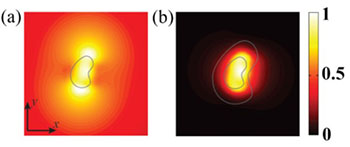
Simulated electric-energy distribution in 2-D dielectric waveguide without metamaterial cladding (a) and with cladding (b). The addition of the cladding dramatically increases the fraction of total power confined within the waveguide core. [Source: Jahani and Jacob, Optica 1, 96 (2014)]
Researchers at the University of Alberta, Canada, have proposed a new approach to confining light at subdiffraction wavelengths, using transparent metamaterials—without creating heat or losing data, and with dramatically reduced crosstalk (Optica, doi:10.1364/OPTICA.1.000096). The team believes that the approach could ultimately spur development of fiber-optic-like “nano-cables” used for interconnects on computer chips, which one of the paper’s authors, Zubin Jacob, calls “the Holy Grail” in nanophotonics.
The continual drive toward miniaturization, power scalability and energy efficiency in computer chips has pushed integration of electronics and photonics at ever-smaller scales. But as the length scales dip below the wavelength of light, problems arise in existing approaches to light confinement. One approach, plasmonics, uses metals to achieve nanoscale waveguiding, but because of the metal’s absorption properties, the light energy is quickly lost and dissipated as heat. All-dielectric approaches to subdiffraction waveguiding, meanwhile, fall prey to crosstalk between waveguides crowded onto a single chip—the bane of nanophotonic integration.
In what they refer to as a “paradigm shift in light-confinement strategy,” Jacob and coauthor Saman Jahani propose focusing not on manipulation of propagating waves within the waveguide, but on the evanescent waves outside of the waveguide core that give rise to crosstalk.
Their approach involves surrounding a conventional dielectric waveguide core with a multilayer metamaterial cladding, consisting of alternating subwavelength layers of germanium (26 nm) and silica (14 nm). The transparent cladding forms an extremely anisotropic medium between separate waveguides. That medium transforms the optical momentum of the evanescent waves entering it, preserving propagation in the direction of the waveguide while causing the component perpendicular to the waveguide to quickly decay.
The result, the authors say, is the potential for all-dielectric waveguides that provide lossless propagation—with crosstalk an order of magnitude lower than seen in alternative approaches. They believe that the work will lead to a new class of devices based on controlling momentum of the evanescent field. “What we’ve done,” asserts Jacob, “is come up with a fundamentally new way of confining light to the nano scale.”
